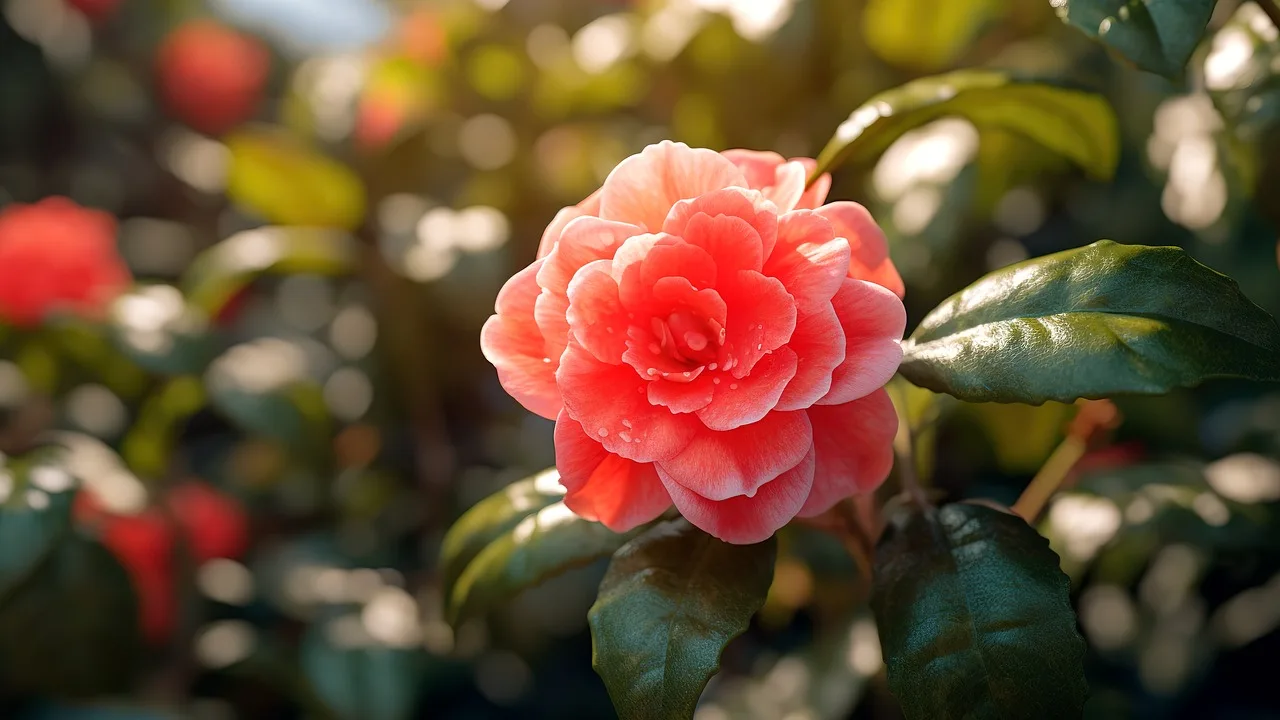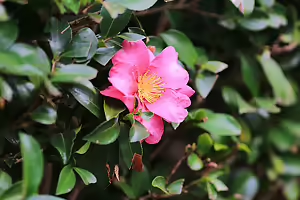
Written by s • Months and Months of Camellias in Bloom – It’s Easy!
If you live in southern parts of the country, you probably know the camellia, that gorgeous evergreen bush with large, often rose-like flowers, at different times during the winter and spring. If you live in more northern areas, you probably think they are not for you, with their need for mild winters and acid soil, but in reality, if you have a cool, bright place to grow them, they are very easy to keep all year round, and even enjoy the blooms indoors. In the days of grand homes and grand balls it used to be fashionable to bring plants in bloom into the ballrooms, and for the women to wear corsages of the flowers – you probably aren’t planning to do that, but nevertheless, camellias are fabulous shrubs to grow. With some planning you can have one or more in bloom starting in fall, and continuing into the spring – something that many people don’t realize.
Not only are there different natural species that bloom at different times, but enterprising plant breeders have crossed some of them together, to create new forms. With the many different types of blooms, in every conceivable shade of palest pink to the darkest burgundy, plus white, you can enjoy a wonderful display for months and months. Let’s take a look at the basic possibilities.
Sasanqua Camellia
This is the camellia bush, called Camellia sasanqua by the botanists, which is going to start your camellia season for you. These naturally bloom in fall, and they are usually finished blooming by Christmas at the latest, and usually earlier. The reason they are not often recognized as different is that they do look almost identical to the spring blooming camellias (we will look at them in a minute), although the bushes are usually more open in shape, and arching, rather than tightly upright. They also grow faster, which is an added bonus, and because they have longer, more flexible branches they can easily be trained onto a wall or trellis, which is a great way to grow them if you have limited space available, or a small garden.
A great place to start to grow these fall and early winter bloomers is with the October Magic® series. These newer varieties have been specially bred not just to bloom from October towards Christmas, but they are smaller than many others, so they fit perfectly in smaller spaces, and even better, they are ideal for pot growing, which means that whatever type of soil you have, or wherever you live, you can grow them. In the garden you need to have acid soil, with a pH close to 5.5, and not above 6.5, for the best growth, but if you don’t have that, then grow them in pots. Make sure the pots have drainage holes, use potting soil and fertilizer for acid-loving plants, and you can grow them easily.
If you live in zones cooler than zone 7, which is their limit for outdoor hardiness, then you can bring your pots inside once freezing temperatures are approaching. The ideal winter environment is a cool, well-lit place, with bright filtered light. A glassed-in porch is often perfect, and if it doesn’t have any heat, just add a temperature-controlled heater that will come on when the temperature drops below 35 degrees, and you will have them blooming away while the frost bites outdoors. How cool is that! A couple of great choices from the October Magic® series are White Shi-Shi™, with pristine, pure-white flowers in a formal shape of neatly arranged petals in geometric circles, and Sparkling Burgundy™, with more informal flowers in a delicious shade of deep pink, and a cluster of irregular petals surrounded by a circle of outer ones, like a peony.
Japanese Camellia
This species, Camellia japonica, is the most well-known type of camellia, and it is the type most widely grown all over the world where the climate is suitable. This is the plant often called Rose of Winter, or Rose of the South. These have a very upright, dense form, and most grow between 5 and 10 feet tall, and often just as wide. They usually flower between January and March, but some varieties flower earlier or later than that.
With such a wide range of forms, there are Japanese camellias for every taste. As for color, all possible shades between pure-white, cream, pink, and the darkest reds are found. As well, there are exotic forms with white or pink petals splashed with darker pink or red, often with every flower turning out differently. Blooms last a long time in the garden, with the cooler winter weather, and they can be brought inside and dropped into a bowl of water, where they will last for days and days. Maybe another time we will go into more detail, but since we are talking about extending the camellia season beyond spring, let’s move on.
Hybrid Camellias
Some plants casually called ‘sasanqua’ are really hybrids, called Camellia x hyemalis, or Camellia x vernalis, which were created by crossing a sasanqua camellia with a Japanese camellia. As we might expect, these bloom between Christmas and late winter, filling the gap between the two main types. With these in your collection you keep the party going through what otherwise would be a few bloomless months, between the two main types.
A great plant that will usually bloom exactly for Christmas is the variety called ‘Yuletide’, which has the perfect big Christmas-red blooms, in an open form, with a brush of yellow stamens in the center. Sometimes starting in October, this great plant blooms for months, and will usually give you blossoms to decorate the Christmas table – what more could you wish for?
Another beautiful hybrid variety to look for is a Japanese original called ‘Kanjirô’. This vigorous grower is a beautiful mid-pink, and well worth waiting for if you don’t find it immediately. Unlike most other hybrids, it blooms in fall, alongside the true sasanqua varieties.
One hybrid we can’t overlook is the ‘Two Marthas’ variety. We don’t know who the two women were, but we do know what a great fall-blooming variety this is, with its unique lavender-pink blooms. It flowers mostly in October and November, and there are two other reasons to grow this variety. Zone 7, although technically a ‘camellia zone’, can be rough on varieties that bloom in winter. If there is a cold-snap, the flower buds can die, because they are already active, while those on the Japanese camellias are still sleeping, and will survive. But ‘Two Marthas’ can tough it out, and it will bloom reliably in zone 7. Amazingly, it is also a top-choice for Florida and hot areas where many varieties can succumb to the heat. Make sure you give this beauty a go in your garden.
Another great bloomer for late winter, just before the spring flowering camellias begin, is ‘Pink Icicle’, with large, gorgeous shell-pink blooms that will win your heart. Now if you live in zone 6, this one is especially interesting because it is one of the hardiest camellias around, and it will grow and bloom in a sheltered spot in zone 6. If you have it there in a pot, you can have the insurance of bringing into a protected shed or garage for a night or two if there is an extreme cold-snap, so go for it, and be the person in your neighborhood with a camellia in the garden. Depending on where you grow it, this beauty will bloom in February, March or April, long before anything else in your garden gets going.
You can see by now that with all these choices, all it takes is a little careful shopping to fill your garden with camellia blooms from fall to spring, making winter an exciting time in the garden, and filling the time until spring and summer blooms return again.






